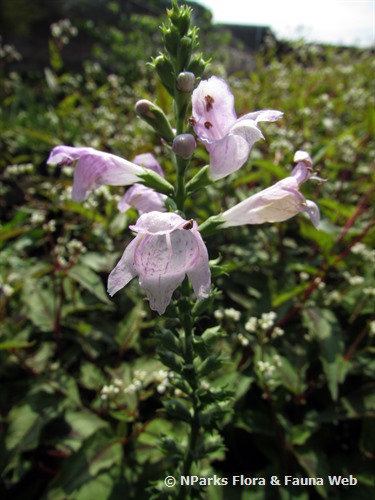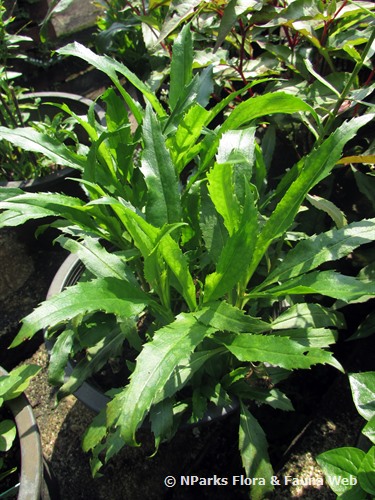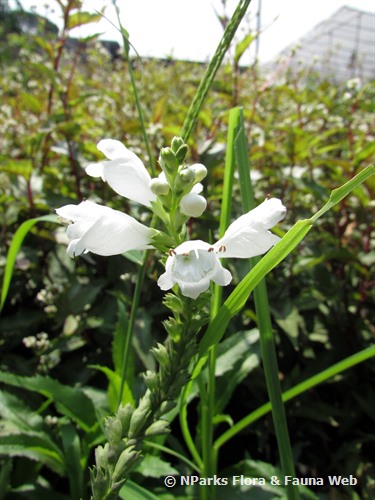
Back
Physostegia virginiana (L.) Benth.
| Family Name: | Lamiaceae (Labiatae) |
| Common Name: | Obedient Plant, False Dragonhead |
Name
Classifications and Characteristics
| Plant Division | Angiosperms (Flowering Seed Plants) |
|---|---|
| Plant Growth Form | Herbaceous Plant |
| Lifespan (in Singapore) | Perennial |
| Mode of Nutrition | Autotrophic |
Biogeography
| Native Distribution | North America |
|---|---|
| Native Habitat | Terrestrial |
| Preferred Climate Zone | Temperate |
| Local Conservation Status | Non-native |
Description and Ethnobotany
| Growth Form | A herbaceous and rhizomatous perennial that grows up to 1.2 m tall. Plant tends to form clumps. |
|---|---|
| Roots | Shallow roots. |
| Foliage | Oppositely arranged leaves, narrow-lanceolate in shape. Leaves have sharp toothed margin. |
| Stems | Squarish stems, rhizomatous. |
| Flowers | Flowers are borne in cluster called as spike inflorescence growing to about 45 cm long. Flowers will bloom from bottom to the top of the inflorescence. Each flower is lilac to pink, tubular and has 5 lobes: with two lobes forming the upper lip, and three forming a lower lip. |
| Habitat | In its natural habitat, it is found in open meadows, stream banks, and in prairies. |
| Cultivation | Plants can be propagated by root division. Taller plant may require staking. |
| Etymology | The genus Physostegia means inflated-cover, which refers to the inflated calyx. The specific epithet virginiana means from Virginia, USA that shows the native range for this plant. |
Landscaping Features
| Landscaping | If the flowers are bent, they tend to stay in that new position for some time, hence the common name, Obedient Plant. |
|---|---|
| Desirable Plant Features | Ornamental Flowers |
| Landscape Uses | Flowerbed / Border |
Fauna, Pollination and Dispersal
| Fauna Pollination Dispersal Associated Fauna | Bird-Attracting (Flowers) |
|---|---|
| Pollination Method(s) | Biotic (Fauna) |
Plant Care and Propagation
| Light Preference | Full Sun |
|---|---|
| Water Preference | Moderate Water |
| Rootzone Tolerance | Moist Soils, Well-Drained Soils |
| Potential Problems | No serious pests or disease problems. However, watch for aphids or spider mites. |
Foliar
| Foliage Retention | Evergreen |
|---|---|
| Mature Foliage Colour(s) | Green |
| Prominent Young Flush Colour(s) | Green |
| Foliar Type | Simple / Unifoliate |
| Foliar Arrangement Along Stem | Opposite |
| Foliar Attachment to Stem | Petiolate |
| Foliar Shape(s) | Non-Palm Foliage (Lanceolate) |
| Foliar Margin | Serrate / Toothed |
| Foliar Apex - Tip | Acute |
| Foliar Base | Acute |
Non - Foliar and Storage
| Root Type | Underground |
|---|
Floral (Angiosperm)
| Flower & Plant Sexuality | Bisexual Flowers |
| Flower Colour(s) | Pink |
|---|---|
| Flower Texture(s) | Smooth |
| Flower Grouping | Cluster / Inflorescence |
| Flower Location | Axillary |
| Flower Symmetry | Bilateral |
| Individual Flower Shape | Tubular |
| Inflorescence Type | Spike |
Image Repository
Others
| Master ID | 33634 |
|---|---|
| Species ID | 8048 |
| Flora Disclaimer | The information in this website has been compiled from reliable sources, such as reference works on medicinal plants. It is not a substitute for medical advice or treatment and NParks does not purport to provide any medical advice. Readers should always consult his/her physician before using or consuming a plant for medicinal purposes. |


.jpg)
.jpg)
.jpg)
.jpg)
